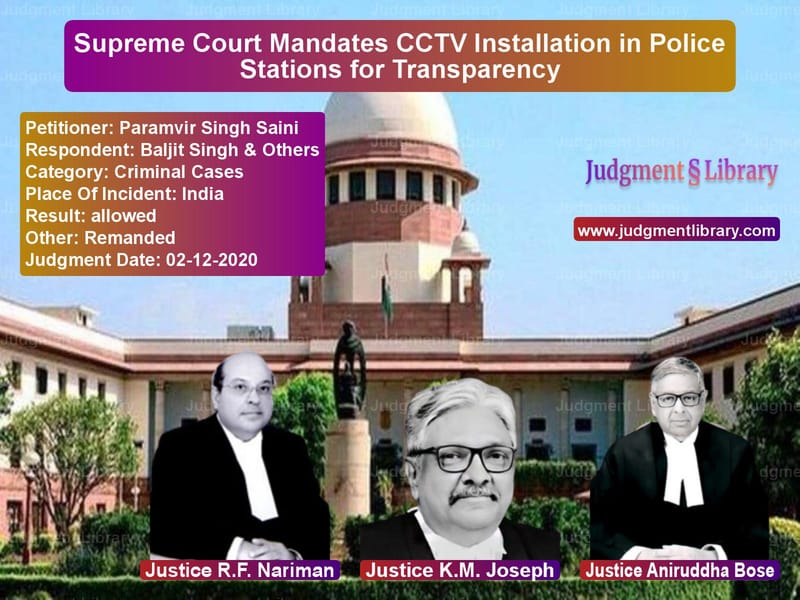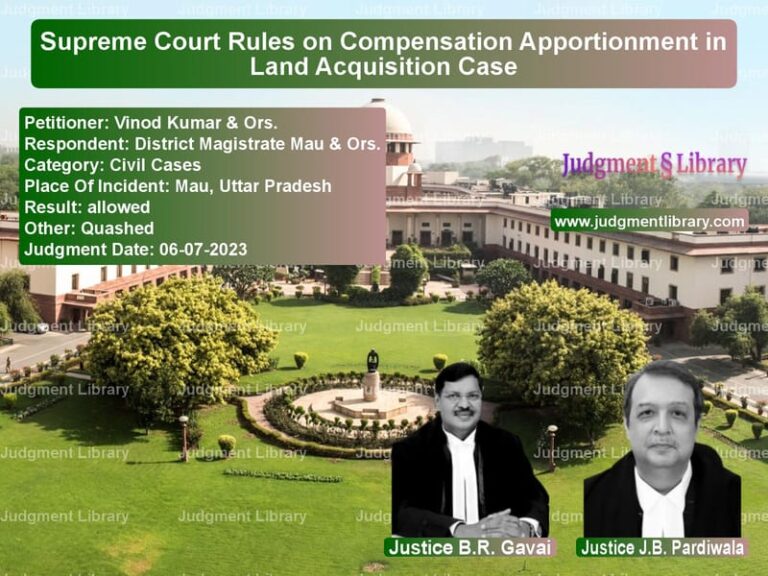Supreme Court Mandates CCTV Installation in Police Stations for Transparency
The case of Paramvir Singh Saini vs. Baljit Singh & Others revolved around the need for transparency in law enforcement through the installation of CCTV cameras in police stations across India. The Supreme Court was tasked with determining whether the absence of CCTV cameras in police stations, despite previous orders, violated fundamental rights under Article 21 of the Indian Constitution.
The petition challenged the lack of implementation of directions given in Shafhi Mohammad v. State of Himachal Pradesh (2018), where the Supreme Court mandated that a Central Oversight Body (COB) be set up to oversee crime scene videography and transparency in police stations. Despite orders, several states failed to implement these directions, leading to custodial violence complaints without evidence to corroborate the incidents.
Background of the Case
- The Supreme Court had earlier mandated CCTV installation in police stations to enhance transparency and curb custodial torture.
- The petitioner, Paramvir Singh Saini, filed a petition stating that several states had failed to implement these orders.
- The petition sought immediate compliance with prior directions regarding the installation of CCTVs and storage of recordings.
- The government was asked to provide a status report on compliance with previous orders.
Petitioner’s Arguments
The petitioner, Paramvir Singh Saini, contended that:
- Despite prior orders, most police stations lacked CCTV cameras, leading to a lack of accountability in custodial violence cases.
- The Right to Life under Article 21 includes protection against torture and ill-treatment in police custody.
- Failure to install CCTVs resulted in human rights violations, as complaints of custodial violence went unverified.
- The lack of implementation showed negligence on the part of law enforcement agencies.
- Immediate action was needed to ensure that all states complied with the orders without delay.
Respondent’s Arguments
The Union of India and various state governments countered:
- The implementation was delayed due to budgetary constraints and logistical challenges.
- Several states had initiated the process of installation but had not completed it.
- Issues related to data storage and real-time monitoring were being addressed.
- Steps were being taken to ensure compliance, but further time was needed to implement the orders fully.
Supreme Court’s Observations
The Supreme Court, in its judgment delivered by Justices R.F. Nariman, K.M. Joseph, and Aniruddha Bose, addressed the crucial aspects of law enforcement transparency.
1. Mandate for CCTV Installation
The Court held:
“Transparency in law enforcement is essential to prevent abuse of power. Installing CCTV cameras in police stations ensures accountability and safeguards fundamental rights.”
The Court directed:
- All police stations across India must install functioning CCTV cameras without further delay.
- Cameras must be installed at all entry and exit points, lock-ups, interrogation rooms, corridors, and reception areas.
- CCTV footage must be stored for at least 18 months to allow adequate time for investigation.
2. Compliance Reports and Oversight
The Court directed:
- Each state must file a compliance affidavit detailing the number of CCTV cameras installed and their locations.
- A State Level Oversight Committee (SLOC) must be formed, including the Home Secretary, Finance Secretary, and Director General of Police.
- Every district must have a District Level Oversight Committee (DLOC) to ensure proper functioning of CCTVs.
3. Protection of Human Rights
The Court emphasized:
“Human rights violations in police stations must be addressed immediately. CCTV footage will serve as evidence to prevent abuse and ensure justice.”
The ruling reaffirmed that police officials would be held accountable for any missing or tampered CCTV footage.
Final Judgment
- The petition was allowed, directing all states to comply with the previous orders.
- The government was given six weeks to submit compliance reports.
- Failure to implement the orders would invite contempt proceedings against responsible officers.
Implications of the Judgment
This ruling has significant implications:
- Ensures accountability in police investigations.
- Reduces custodial violence by providing video evidence of interrogations.
- Mandates regular oversight through state and district committees.
- Strengthens protection of fundamental rights under Article 21.
- Establishes CCTV recordings as admissible evidence in court.
The Supreme Court’s ruling enforces long-overdue police reforms, ensuring that law enforcement agencies operate transparently and fairly.
Petitioner Name: Paramvir Singh Saini.Respondent Name: Baljit Singh & Others.Judgment By: Justice R.F. Nariman, Justice K.M. Joseph, Justice Aniruddha Bose.Place Of Incident: India.Judgment Date: 02-12-2020.
Don’t miss out on the full details! Download the complete judgment in PDF format below and gain valuable insights instantly!
Download Judgment: Paramvir Singh Saini vs Baljit Singh & Other Supreme Court of India Judgment Dated 02-12-2020.pdf
Direct Downlaod Judgment: Direct downlaod this Judgment
See all petitions in Custodial Deaths and Police Misconduct
See all petitions in Public Interest Litigation
See all petitions in Fundamental Rights
See all petitions in Judgment by Rohinton Fali Nariman
See all petitions in Judgment by K.M. Joseph
See all petitions in Judgment by Aniruddha Bose
See all petitions in allowed
See all petitions in Remanded
See all petitions in supreme court of India judgments December 2020
See all petitions in 2020 judgments
See all posts in Criminal Cases Category
See all allowed petitions in Criminal Cases Category
See all Dismissed petitions in Criminal Cases Category
See all partially allowed petitions in Criminal Cases Category







